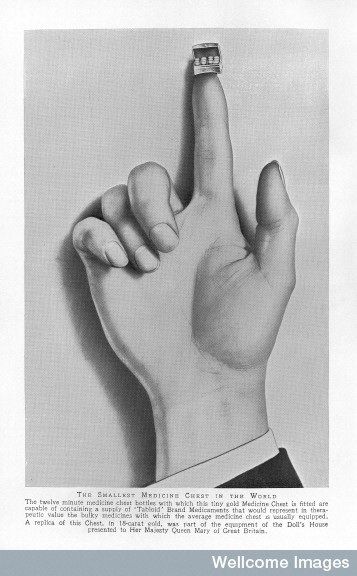The American-born pharmaceutical entrepreneur Sir Henry Wellcome dreamed of creating the world’s greatest museum of medicine. His enormous wealth and ambition led him to acquire a collection so vast that, at his death, it still lay in warehouses, unseen and incomplete - allegedly with more items than held by the Louvre. Today, after decades of work by his successors, parts of the collection can been seen around the world. In the original post below, Frances Larson, author of An Infinity of Things: How Sir Henry Wellcome Collected the World, tells us about one of those pieces: the smallest medicine case in the world.
It was not much bigger than a sugar cube. ‘The smallest medicine chest in the world’ was less than two centimeters wide but it was fitted with twelve tiny bottles. Together, they held fifteen pints of fluid medicine in condensed form: there were 300 doses of medicine in this miniature magic box. It was a technological marvel, a work of art.
 The idea for the tiny medicine case came from Henry Wellcome, proprietor of the international pharmaceuticals firm Burroughs Wellcome and Company. He had walked into a meeting one day, taken a tiny golden box out of his waistcoat pocket and, to the astonishment of his audience, announced that he wanted it made into a medicine chest.
The idea for the tiny medicine case came from Henry Wellcome, proprietor of the international pharmaceuticals firm Burroughs Wellcome and Company. He had walked into a meeting one day, taken a tiny golden box out of his waistcoat pocket and, to the astonishment of his audience, announced that he wanted it made into a medicine chest.
Henry Wellcome regularly expected the extraordinary. If any of his employees protested against his plans, he would put his hand on their shoulder, look them straight in the eye, say, ‘You know, I think it could be done if we could find the right man’, and walk away. He was rarely disappointed.
‘The smallest medicine chest in the world’ was an advertising masterpiece. It was photographed balancing on the tip of a man’s finger. The upward pointing finger directed attention to the miniature box while acting as the perfect measure of scale. Burroughs Wellcome were presented as magicians, conjuring a generous supply of medical cures from a few drops of liquid.
Image reproduced with permission, Wellcome Library, London
The image was apt, because the Burroughs Wellcome were famous for their compressed medicines. In 1884, Henry Wellcome had coined the word Tabloid, now more commonly associated with ‘downscale’ newspapers, to describe his firm’s compact products. Hundreds of gelatin-coated pills and compressed tablets were manufactured every minute in their factories. They were so beautiful, according to the British Medical Journal, that they ‘might almost be mistaken for sweets’.
Few people knew how these beautiful preparations worked. They were developed in research laboratories of the highest caliber, but the firm’s procedures were a closely guarded secret. Orders were made through special channels to disguise their interests, identifying marks were chiseled off new equipment, and every member of staff signed a detailed confidentiality agreement. Medicine had never been so simple, so efficient, or so mysterious.
Compressed medicines were perfect for travel, and Burroughs Wellcome medicine cases became market leaders. They were designed to fit every means of transportation, whether it was the handlebars of a bicycle, the cockpit of an aeroplane, or the runners of a sledge. Burroughs Wellcome medicines had been ‘First at the North Pole and First at the South Pole’: Amundsen, Scott, Shackleton and Peary had all embarked on their polar expeditions with Burroughs Wellcome equipment.
The medicine cases were available in a range of finishes: crocodile leather, bronzed aluminium, silver, doeskin. Such stylish coverings hinted at the desirability of the objects within. These products blurred the boundaries between looking good and feeling good: clasps clicked smoothly, corners were polished smooth, hinged racks swung out and revolved automatically, offering up neat rows of syringes and tiny tubes of tablets. Burroughs Wellcome manufactured a sense of control in material form, and Henry Wellcome knew that small things could make a big difference.
Henry Wellcome was a perfectionist. One of his employees remembered that ‘under his direction one learned to pay special attention to minute detail’. He constantly pushed his staff to raise their standards. No job was too small, whether it was improving the stopper on a tube of insect repellent or testing the effects of water on soap wrappings.
‘The smallest medicine chest in the world’ encapsulated all these qualities: precision, convenience and hidden power. It sent a message that people no longer had to worry about their health, because Burroughs Wellcome had done all the worrying for them. In the early 1920s a replica chest in fifteen carat gold was made for Queen Mary’s dolls’ house, a fact that Burroughs Wellcome were quick to publicize. The implication was clear: thanks to their hard work, good health had become child’s play.
Based on documents kept at the Wellcome Library (file references: WF/M/H/07/04, WA/HSW/PE/C.23 and WF/M/H/07/01). British Medical Journal, 25 July 1885, 155.



